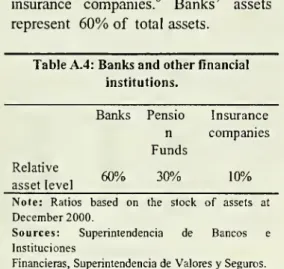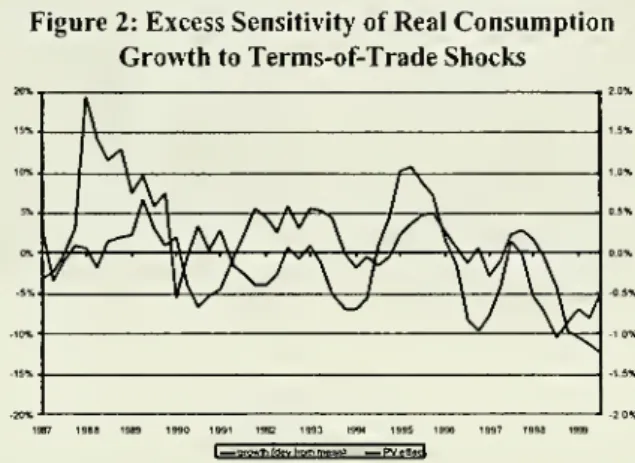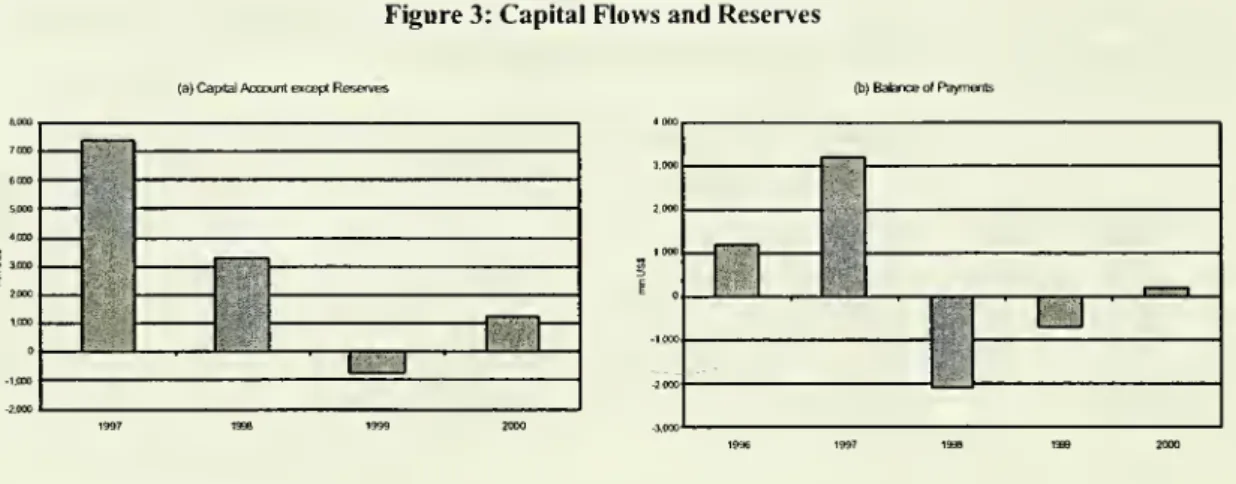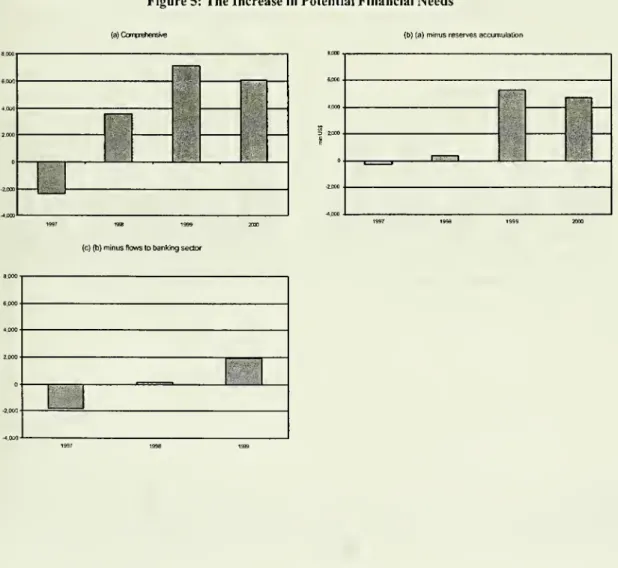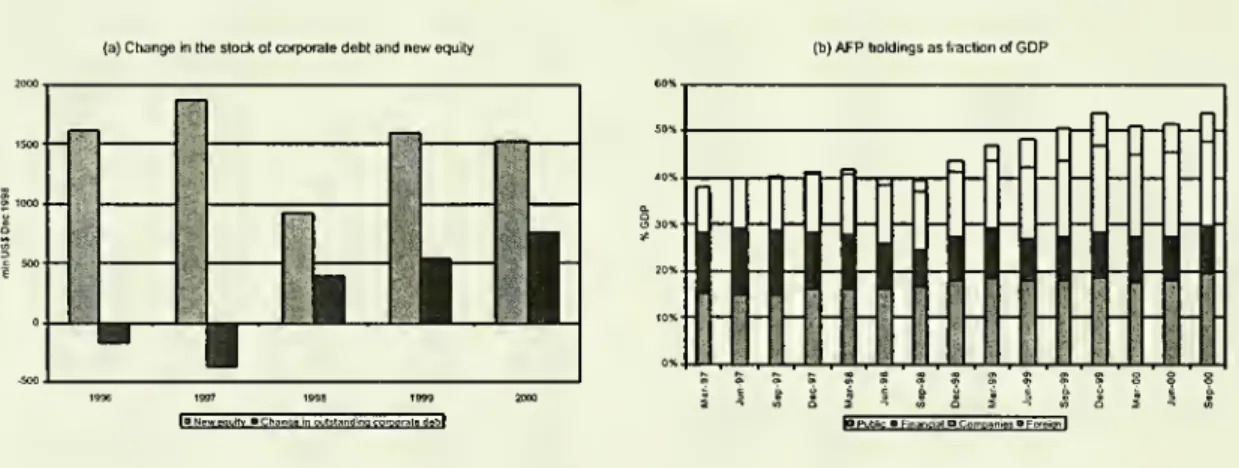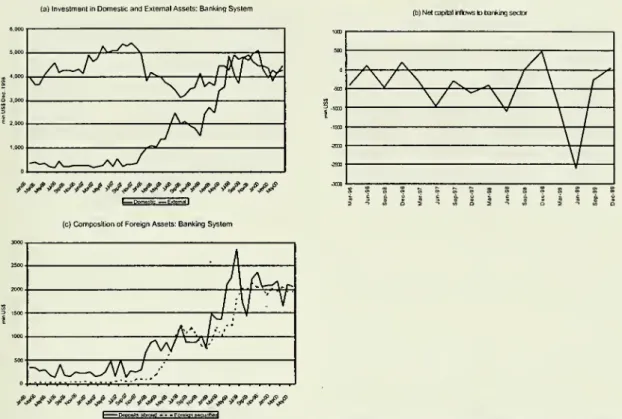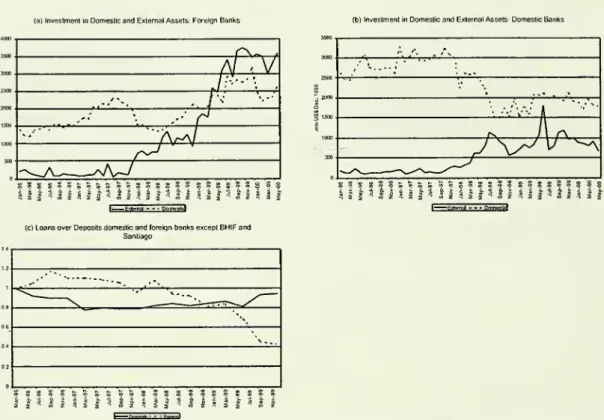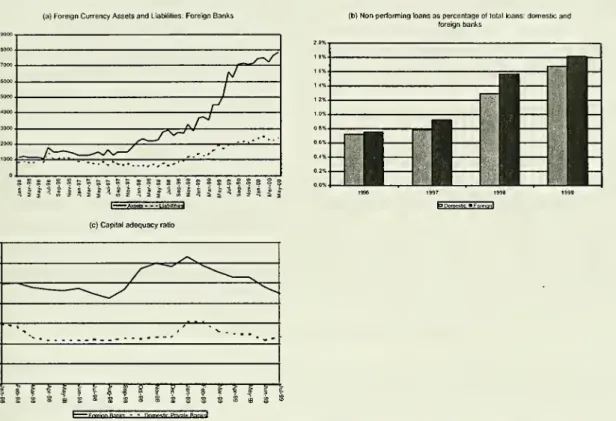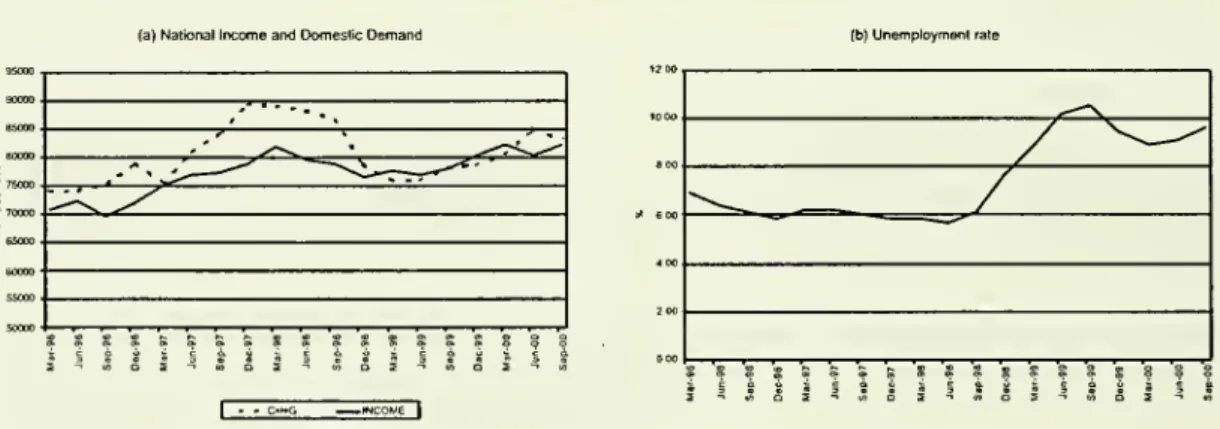Digitized
by
the
Internet
Archive
in
2011
with
funding
from
Boston
Library
Consortium
IVIember
Libraries
L j 15
Dewey
oi-
I3
'-1^Massachusetts
Institute
of
Technology
Department
of
Economics
Working
Paper
Series
COPING
WITH
CHILE'S
EXTERNAL
VULNERABILITY:
A
FINANCIAL
PROBLEM
Ricardo
J.
Caballero
WORKING
PAPER
01-23
REVISED,
January 2002
Room
E52-251
50
Memorial
Diive
Cambridge,
MA
021
42
This
paper
can be downloaded
without
charge
from
the
Social
Science Research Network
Paper
Collection
at
http://papers.ssrn.
c
\(y
Massachusetts
Institute
of
Technology
Department
of
Economics
Working
Paper
Series
COPING
WITH
CHILE'S
EXTERNAL
VULNERABILITY:
A
FINANCIAL
PROBLEM
Ricardo
J.Caballero
WORKING
PAPER
01-23
REVISED,
January 2002
Room
E52-251
50
Memorial
Drive
Cambridge,
MA
02142
This
paper
can
be
downloaded
without
charge
from
the
Social
Science
Research
Network
Paper
Collection
at
http://papers.ssrn.
conn/abstract=274083
'.GHUSETTS INSTITUTE
OFTECHMOLOGY
H'AR
7
2002
Coping
with
Chile's
External
Vulnerability:
A
Financial
Problem
01/11/2002
Ricardo
J.
Caballero'
Abstract
With
traditionaldomestic imbalances long
under
control, theChilean business
cycle isdriven
by
external shocks.Most
importantly,Chile
'sexternal vulnerability isprimarily
a
financial
problem.
A
decline in theChilean
terms-of-trade,for
example,
isassociated
toa
decline in realGDP
thatismany
timeslarger
than
one
would
predict
in thepresence of
perfect financial markets.
The
financialnature
of
this excess-sensitivityhas two
centraldimensions:
a sharp
contraction in Chile'saccess
tointernationalfinancial
markets
when
itneeds
it themost;
and
an
inefficientreallocationof
thisscarce access
across domestic
borrowers
during
external crises. In thispaper
I
characterize thisfinancial
mechanism
and
argue
that Chile'saggregate
volatilitycan
be reduced
significantlyby
fostering
theprivate
sector'sdevelopment of
financialinstruments
thatare contingent
on
Chile
'smain
external shocks.
As
a
first step, theCentral
Bank
or
IFIscould
issuea
benchmark
instrument
contingent
on
theseshocks. I alsoadvocate
a
countercyclicalmonetary
policy
but
mainly for
incentive—
that is,as
a
substitutefor
taxeson
capital inflowsand
equivalent
measures
—
rather than for
ex-postliquiditypurposes.
'
MIT
and
NBER.
e-mail: caball(a)mit.edu; http://web.mit.edu/caball/www.
Prepared
for theBanco
Centralde
Chile. Iam
very grateful VittorioCorbo, Esteban
Jadresic,and
Norman
Loayza
fortheircomments;
toAdam
Ashcraft,Marco
Morales
and
especiallyClaudio
Raddatz
for excellent research assistance;
and
toHerman
Bennett for his effort collectingmuch
of
theI.
Introduction
and Overview
With
traditionaldomestic imbalances longunder
control,the Chilean business cycle isdrivenby
extemal shocks.
Most
importantly, Chile'sextemal
vulnerabilityisprimarilya financialproblem.A
decline intheChilean
terms-of-trade, forexample,
is associatedtoa declinein realGDP
thatis
many
times larger thanone
would
predict in the presenceof
perfect financial markets.The
financial nature
of
this excess-sensitivity hastwo
central dimensions: a sharp contraction inChile's access to international financial
markets
when
itneeds
it the most;and an
inefficientreallocation
of
this scarce access acrossborrowers
duringextemal
crises. Iargue
that Chile'saggregatevolatility
can
be
reduced
significantlyby
fosteringthe private sector'sdevelopment of
financial instruments that are contingent
on
themain
extemal
shocks
facedby
Chile.As
a first step,the CentralBank
orIFIscouldissueabenchmark
instrument contingenton
these shocks.Ialsoadvocate acountercyclical
monetary
pohcy
(alsocontingenton
theseshocks)butmainly
forincentive
—
that is, as a substitute fortaxeson
capital inflowsand
equivalent—
ratherthan forex-post hquidity purposes.
The
essenceof
themechanism
through
which
extemal shocks
affect theChilean
economy
can
be
characterized as follows: First,there is adeteriorationof
terms-of-tradethat raises theneed
for
extemal
resources ifthe realeconomy
istocontinue unaffected,butthistriggers exactlytheopposite reaction fi^om international financiers,
who
puU back
capital inflows. Occasionally, thelatteroccurs directly as part
of
"contagion" effects.Second,
once extemal
financialmarkets
faUto
accommodate
theneeds
of domestic
fiimisand
households, these agents turn todomestic
financial maricets,
and
tocommercial banks
inparticular. Again, this increase indemand
is notmatched by
an
increase in supply asbanks
—
particularly resident foreign institutions-
tightendomestic
credit, opting instead to increase their net foreign asset positions. Third, there is significant "flight-to-quaUt}^' within the domestic financial system,which
reinforces theabove
effects as large firms find it
more
attractive to seek financing indomestic
markets, incircumstances that the displaced small
and
medium
size firms cannot access intemationalfinancial
markets
atany
price.The
costsof
thismechanism
are high.Widespread
financial constraints are binding during thecrisis,
when
major
forced adjustments are needed.The
sharp decline indomestic
asset prices,and
corresponding rise in expected returns, is drivenby
theextreme
scarcity in financialresources
and
theirhigh
opportunitycost.Even
thepraisedrise inFDI
thatoccurred duringthemost
recentcrisisisasymptom
of
thesefiresales.The
fact thatthisinvestment takes theform
of
control-purchases rather than portfoUo or credit flows
simply
reflectssome
of
the underlyingproblems
that Limit Chile's integration to intemational financial markets:weak
corporategovernance and
other "transparency" standards. Finally, the costsdo
notend
with
the crisis, as financially distressedfirms are iUequipped
tomount
aspeedy
recovery.The
latteroftencomes
not only withthe costs
of
aslow
recoveryinemployment
and
activity,butalsowith aslowdown
in the process
of
creative destmctionand
productivity growth. In the U.S., the lattermay
account
forabout
30%
of
the costsof
an average
recession (see Caballeroand
Hammour,
the presence
of
a largenumber
of
financially distressed small firms,when
severe enough,reduces rather than
enhances
the effectivenessof
monetary
policy in facihtating the recovery(seebelow).
The
distnbutional impactof
thistypeof
crisis is significant as well.On
one
end, large firms aredirectlyaffected
by
external shocks butcan
substitutemost
of
theirfinancialneeds
domestically.They
are affected primarilyby
demand
factors.On
the other, smalland
medium
sized firms (henceforth,PYMES)
arecrowded
outand
are severely constrainedon
the financialside.They
arethe residual claimants
of
thefinancial crunch.-Thisdiagnosis points inthe direction
of
a stmctural solutionbased
on
two
buildingblocks.The
first
one
deals withthe institutionsrequiredtofosterChile's integration to international financialmarkets
and
thedevelopment
of domestic
financialmarkets.Chileismaking
significantprogressalongthis
margin
throughitscapitalmarkets
reform
program.The
second
one,necessaryduringthe unavoidable
slow
natureof
theabove
process, is to designan
appropriate internationalliquidity
management
strategy.The
lattermust
be
understood in terms broader than just themanagement
of
intemational reservesby
the central bank,and
include thedevelopment
of
financial instrumentsthatfacilitatethe delegationof
thistask tothe privatesector.I focus
on
the latter typeof
solutions in this paper.^ Iview
thepohcy
problem
asone
of
remedying
a chronic private sector underinsurance with respect to external crises.' Afteroutlining the
main
sourcesof such
problem
and
the corresponding solutions, I focuson two
of
them.
The
firstone
seeks todevelop
akey
missing market. Ipropose
the creationof
abenchmark
"bond"
that ismade
contingenton
themain
externalshocks
facedby
Chile. Thisinstalment should facilitate the private sector's pricing
and
creationof
similarand
derivativecontingentfinancial instruments.
Inthe
second
one,Idiscussoptimalmonetary
poUcy
and
intemational reservemanagement
fi-oman
insuranceperspective.Provided
thattheCentralBank
of
Chile hasachieved
ahighdegreeof
inflation-target credibility,the optimal responseto
an
externalshock
iswith
amoderate
injectionof
reservesand an
expansionarymonetary
pohcy.The
latter,however,
isunlikely tohave
alargereal impact
and
indeed willimply
a sharp short-Uvedexchange
rate depreciation.The main
benefit
of
suchpohcy
is in the incentives it provides. Itsmain
problem
is that it istime-inconsistent.
Section II describes the essence
of
theextemal
shocksand
the financialmechanism
atwork.
2
See Caballero (1999,2001) fora discussion ofthestructural reformsaimed atimprovingintegration and
thedevelopment offinancial markets.
More
importantly, Chileis inthe process ofenactinga majorcapitalmarketsreform.
Section
in
follows with a discussionof
theimpact of
thismechanism on
the real sideof
theeconomy
and
the differenteconomic
agents. SectionIV
discussespohcy
optionsand
SectionV
concludes.II.
The Shock and
the
Financial
System
In this section I illustrate the
mechanism
though
which
externalshocks
aflFect the Chileaneconomy.
I organize the discussionof
the role playedby
theseshocks
and
their amplificationmechanisms
around
demand
and supply
factors affecting thedomestic banking system
-
thebackbone of
the Chilean financial system.An
overview
of
the Chilean financial institutions ispresentedin
Box
1.
I focus
on
themost
recent cychcal episode, as thechanging
natureof
the Chilean financialsystem
makes
olderdatalessrelevant.//.1
The
External
Shock and
itsImpact
on Domestic
Financial
Needs
The
triggerof
themechanism
isillustratedinFigure 1.Panel(a)shows
thepathof
Chile'sterms-of-trade
and
the spread paidby
prime Chilean
instrumentsover
the equivalent U.S.Treasury
instrument.ItisapparentthatChile
was
severelyaffectedby
both
attheend
of
the 1990s.Panel
(b)offers abettermetricto
gauge
themagnitude of
these shocks.Taking
the quantities firom the1996
cvirrentaccount
as representativeof
those thatwould have
occurred
in theeconomy
absent
any
real adjustment, it translatesthem
into the dollar losses associated to thedeterioration in terms-of-trade
and
interestrates. In 1998, these lossesamounted
toabout
2%
of
GDP,
with
similarmagnitudes
for1999
and
2000.Box
1:
The
Chilean
Banking
Sector
Banks
are an important sourceof
financingfor Chilean firms.
The
composition offinancing (table A.l) is similar to that of
advanced European
economies. Unlike thelatter,
and
much
like theUS,
the maturity structure of Chileanbank
loans ismore
concentrated
on
the short end:57%
oftotalloans,
and
60%
of
commercial
loans, have amaturity of less than 1 year. In
summary,
Chilean banks look like
European
banks interms oftheir relativeimportance butlike
US
banks
in termsof
their focuson
shortmaturities.
Relative
importance:
Loans
versus
other instruments.
TableA.l:
The
relativeimportance ofbank
loans. Source offinancing Loans Equity
Bonds
Stock Flows43%
51%
54%
33%
3%
16%
Note: Participations built using the stocks at
December 2000. Flows were computed as the
difference in stocks between December 1999 and
December 2000 except for the flow of new equity,
which wasbuiltusinginformationonequity placement duringthe period.
Composition
of
Loans.
Chilean banks concentrate
most
of
theiractivity
on
firms.Commercial
loans represent around60%
of totalbank
loans(see Table A.2).
Adding
trade loans, about70%
oftotalbank
credit supply isdirected to firms.TableA.2:Compositionofloansbyuse.
Typeof loan Fracti(>noftotalloans
Commercial
60%
Residential
15%
Consumption
10%
Trade
10%
Other
5%
Source:SuperintendenciadeBancoseInstituciones
Financieras.
Composition
of
commercial
loans
by
firm
size.Chilean
banks
concentrate their lendingactivity
on
large fums,atleastwhen
firmsize is approximated
by
loan size.Around
65%
of thevolume
of
commercial
loans is allocated to loansabove
US$
1.The
relativeimportanceof
different loan sizes issummarized
inTableA.3.
TableA.3:
The
relativeimportanceofdifferentloansizes.
Loansize Fractionofthevolumeof commercialloans
Large
64%
Medium
14%
Micro
22%
Note: Large: all loans above 50,000 UF (around
US$ 1.4 millions (end of 1999 dollars)); Medium:
loansbetween10,000and 50,000
UF
(US$280,000 andUS$ 1,400,000); Micro: loansbelow 10,000UF
(US$280,000).
Source:Superintendencia deBancoseInstituciones
Financieras.
Banks
versus other
financialinstitutions.
''Computedusing the stock
ofloansinDecember 1999. Source Superinlendencia de Bancos e Jns/i/imones Financieras.
^ In Germany, for example, more that
70%
of the commercialloansarelongterm. In contrast,intheUS
short term loans account for about60%
ofnon-residentialloans.
Banks
in Chile are importantwhen
compared
withotherfinancial institutionsas well. Table
A.4
compares
the total assetsof
banks, pension fiinds,and
insurance companies.^
Banks'
assets represent60%
of
total assets.TableA.4:Banks andotherfinancial
institutions.
Banks Pensio Insurance
n companies
Funds
Relative assetlevel
60%
30%
10%
Note: Ratios based on the stock of assets at
December2000.
Sources: Superintendencia de Bancos e
Instituciones
Financieras,Superintendencia de ValoresySeguros.
Domestic
and
Foreign banks.
Foreign
banks
presence is verysignificant. Table
A.5
shows
that loansby
foreignbanks
representedaround
40%
of total loans in 1999. It isimportant to note that Chilean
Banking
Law
does not recognize subsidiariesof
foreign
banks
as partof
theirmain
headquarters.
TableA.5:DomesticandForeign
Banks
Domestic Foreign Relativeimportance (%) total loans)
58%
42%
Portfoliocomposition Loans80%
67%
Securities11%
14%
Foreignassets6%
15%
Reserves3%
4%
Note:RatiosbasedonDecember1999values.
Source:Superintendencia deBancoseInstituciones Financieras.
Total assetsisthesumoffinancialandfixedassets.
Fixedassets arenotincludedforinsurancecompanies. Nevertheless, fixed assets represent averysmall fractionoffinancialinstitutions' assets.
Figure1:ExternalShocks
(a) TefTTis otTradeand Sovereign Spread (b)TermsofTradeandInterestRateeffect(fixedquanlities) I1U1MJ
~>
' ^\
/
V
V
y
V
' \A
V
^s
-
1;\/
" •^y
_^ / <• ——
~- _._.^.• ' i 1 I 1 i-1. i \ '^ I i \ '^ s s 1 ? i i 1 s—
./',^
Hi
fiHi
f
-4
< ^'"' 1 [ TemaoltfjdB—-St»B3dEntnaEr»tea|HTT eHecl li.rnri.slram BffT^
Notes:Preliminarydata used for 1999and2000. TheyearlyFigure for2000 was computed multiplyingthe S quarters cumulative value by4/3. (a) Terms-of-tradeis the ratio ofexports price indexand import price indexcomputedbythe
CentralBank. Thesovereignspreadwas estimated asthe spread ofENERSIS-ENDESAcorporatebonds. The spreaddata for 1996wasestimatedbytheauthorusing informationfromtheCentralBankofChile, (b) Theterms-of-tradeeffectwas
computedas thedifferencebetweenthe actual terms-of-tradeandtheterms-of-tradeat 1996quantities. The interestrate effectwas computedinsimilar fashion
Source:BancoCentraldeChile.
How
should Chilehave
reacted to this sharp decline innational income, absentany
significantfinancial friction (aside
from
thetemporary
increase inthe spread)? Figure2
hints the answer.The
thin line depictsthe pathof
actualconsumption
growth, while the thick line illustrates the hypothetical pathof
Chile'sconsumption
growth
ifitwere
perfectly integrated to international financialmarkets
and
terms-of-trade the only sourceof
shocks.'There
aretwo
interesting features inthe figure. First, there isa veryhigh
correlationbetween
Chile's business cycleand
shocks
to its terms-of-trade. This correlation is notobserved
in othercommodity
dependent
economies with
more
developed
financial markets,such
as AustraliaorNorway
(seeCaballero1999
or 2001).Second,
and
more
importantly for theargument
in this paper, the actualresponse
of
theeconomy
isbeingmeasured
on
theleftaxiswhilethatof
the hypotheticalisbeingmeasured
on
the right axis.Sincethe scale in theformer
isten timeslargerthanthatof
thelatter,itisapparentthat the
economy
over-reacts totheseshocks
by
asignificantmargin. Inpracticeshocks to the terms-of-trade are
simply
too transitory, especiallywhen
they are drivenby
demand
as inthe recentcrisis, to justify alarge responseof
the real sideof
theeconomy.^
The
Consumption growth is very similar to
GDP
growth for thiscomparison. Adding the income effect ofinterest rate shocks
would
not change things toomuch
as these were very short-lived. I neglect thepresence of substitution effects because there is no evidence of a consumption overshooting once
income
effect that ismeasured
in panel (b)of
Figure 1 should in principle, but itdoes
not inpractice, translate almostentirely inincreased
borrowing
from
abroad.Figure2:ExcessSensitivityofReal
Consumption
Growth
toTerms-of-Trade Shocks1SB7 13BS
I af.Brtif<Wl7W.m«in) PV^g^
Notes:consumptiongrowthfromIFS, copperprices(London Metal Exchange)fromDatastream,copperexportsfromMin. de Hacienda.
Returning to the late
1990s
crisis, panel (a)of
Figure 3 illustrates that international financialmarkets
not only did notaccommodate
the (potential) increase indemand
forforeign resources butactually capital inflows declinedrapidly overthe period. Panel(b)documents
thatwhilethe centralbank
offset partof
this declineby
injectingback
some
of
its international reserves, itclearly
was
not nearlyenough
tooffsetboth
the declinein capitalinflowsand
therisein externalneeds.
For
example,
the figureshows
that in 1998, the injectionof
reservesamounted
toapproximately
US$2
bilhondollars. Thisiscomparable
tothedirectincome
effectof
the declineinterms
of
tradesand
rise in interest rates,butitdoes
notcompensate
forthe declinein capitalinflowsthat
came
with these shocks.'
The
price ofcopper has trends and cycles at different frequencies,some
ofwhich are persistent (seeMarshall and Silva, 1998). But there seemsto be no doubt that the sharp decline in the price ofcopper duringthelate 1990scrisiswasmostlytheresult ofatransitory
demand
shock brought aboutbytheAsian andRussiancrises.1wouldarguethatconditionalontheinformationthatthecurrentshockwas
a transitorydemand
shock,the univariateprocessusedtoestimate the present valueimpact ofthedeclineinthepriceof copperin Figure2, overestimatesthe extentofthis decline.Thelower declinein future pricesisconsistentwith this view.
The
variance ofthe spot price is 6 times the variance of 15-months-ahead future prices.Moreover,theexpectationscomputed fromthe
AR
processtrackreasonablywell theexpectationsimplicitinfuturemarketsbutfortheveryendofthesample,
when
liquiditypremiaconsiderationsmay
havecome
into play.Figure3:CapitalFlowsandReserves
(a) CapitalAccount except Reserves (b)BabncEofPayments ecoD son •1C00 -2.000
"EE
'i^'\r
Ic-^
Source:BancoCentra!deChile
How
severewas
themismatch between
the increase inneeds
and
the availabilityof extemal
financial resources? Figure
4a
has a back-of-the-envelope answer. It graphs the actual currentaccount (lightbars)
and
the current account withquantities fixedat1996
levels(darkbars).At
the trough, in 1999, the actual current account deficit
was
around
US$4
bUhon
smaller thanwhat
one
would
have
predicted using only the actualchange
in terms-of-trade.Moreover,
thisdollaradjustment underestimates the quantityadjustment
behind
it,as the deteriorationof
terms-of-trade typically
worsens
the currentaccountdeficitforany
pathof
quantities.The
importance
of
thisprice-correctioncan
be
seen inpanel (b),which
graphs the actual currentaccount (hghtbars),
and
the currentaccount
at1996
prices (dark bars). Clearly, the lattershows
asignificantlylargeradjustmentthanthe former.
Figure4:
The
CurrentAccount(a)CunentAccajntand CuiTent Accountat1996quantities (b)CunGnt Account(actualandh19g6pnc8s}
S^
t599 2000MCjTtrt /•aInviUSS\» Qjignt Arc|m«USl96il
Notes: (a)Thecurrentaccountat1996quantities was computedbymultiplyingthe1996quantitiesby eachyear'sprice indicesforexports,importsandinterestpayments. Theothercomponents ofthecurrentaccountwerekept at currentvalues,
(b) Thecurrentaccountin 1996priceswas computedbymultiplyingthe1996pricesby each year'squantities.Source:
BancoCentraldeChile
Figure 5 reinforces the
mismatch
conclusionby
reportingincreasingly conservative estimatesof
path
of
thechange
inpotential financialneeds
stemming from
the declinein temis-of-tradeand
capital inflows,and
the increase in spreads. Panel (b)subtractsfrom
(a)the injectionof
reservesby
the central bank, while panel (c) subtractsfrom
(b) thedechne
in capital inflows to thebanking
sector.We
can
seefrom
this figurethatthe increase in financialneeds
for1999
rangesfrom
about$2
bilhons tojustabove $7
billions. Regardlessof
theconcept
used,themismatch
is large, creating a potentially large surge in the
demand
for resourcesfrom
the domesticfinancial system.
The
differencebetween
panel (b)and
(c), as well as the next sectionmore
extensively,
show
that thelatter sectornot only did notaccommodate
this increase indemand,
butalsoexacerbatedthe financialcrunch.
Figure5:
The
IncreaseinPotentialFinancialNeeds(s)CuTprfiensTi/e (b) {a)minusreservesaccumulation
1 6.0X 4,000 1 -S?:;-:C S -2.000
w
^^^^^^^^^^(c)(b)minusflews tobankingsetior
Notes:Panel(a) corresponds to the sum ofthe terms-of-trade effect, the interestrate effect, andthe decline in capital
inflows. Boththe terms-of-tradeandthe interestrateeffectsaremeasuredat1996quantities. Thedeclineincapitalflows correspondsto thedifferenceofthecapitalaccountexceptreserves with respecttoits1996value. Panel(b)subtractsfrom
(a)thenetchangein CentralBankreserves.Panel(c)subtractsfrom panel (b)the net increaseinflows tothe banking
sector. Source:BancoCentraldeChile
To
conclude this section. Figure 6 illustrates otherdimensions
that could have, but did not,smooth
thedemand
for resourcesfrom
resident banks.Panel
(a)and
(b) carry the relatively"good"
news.The
former
panelshows
that issuesof
new
equityand
corporatebonds
did notdecline very sharply, although they hidethe fact that the required
retum
on
these instrumentsrose significantly.
The
latterpanel illustrates that while theAPPs
increased their allocationof
flmds to foreign assets during the period, this portfoho shift occurred
mostly
against publicinstruments.
However,
thisdeclineprobablytranslated intoalargeplacement of
publicbonds
on
some
othermarket
or institution thatcompetes with
the private sector, likebanks
(see thediscussionbelow). Panel (c),
on
the other hand, indicates that retained earnings, a significantsource
of
investment financing to Qiilean firms, declined significantly overthe period.^ Finally,panel (d) illustratesthat
workers
did not helpaccommodating
the financial bottleneckeither,asthelaborshare rosesteadilythroughoutthe period.
Figure6:OtherFactors
{a)Changeinthestock ofcorporatedebtandnewequity (b)AFPholdingsas fracfion ofGDP
_
I
|_
199G 1997 >998 1999
IBNewequJN ChanuBinoulsUntHno corporaiadflbl mPubBe•FinancialaComMriwBFCTCtijiI
Beforethecrises, in 1996, the stock ofretainedearningsrepresented
20%
oftotalassets forthe medianfirm. The difference between profits and dividend payments, a measure ofthe flow ofretained earnings, representedarounda
50%
oftotalcapitalexpendituresforthemedianfirmin 1996.(c)Retained Earnings
I
I
M
10%'.1
'^ 'IH
'
i_
=
;;;^;, -. iDFtow/Opcfabon iSiodt/ToB) |Notes: (a) Source: Bolsa deComerciode Santiago andSuperintendencia de Valoresy Seguros. Newequity valued at
issuanceprice, anddeflatedusing CPI. Thestockof corporatedebt outstandingwasalso deflatedbyCPI. TheDecember 1998exchangeratewas432 pesos perdollar, (b)Source: Superintendencia deAFP. Thevaluesareexpressedas afraction oftheyear'sGDP.(c)ThedataonretainedearningsarefromBolsa de Comerciode Santiago (SantiagoStockExchange)
andcorrespondto thestocksofretainedearning reportedin thebalancesheetsofallthe societiestradedinthaiexchange. Theyexclude investmentsocieties,pensionfunds,andinsurance companies. The flowvaluewas computedasthedifference
inthe (deflated)stocksatIandt-l. (d)Source:BancoCentraldeChile.
The
bottom
lineof
thissectionisclear: dxiringexternalcnmches,
firmsneed
substantial additional financialresourcesfi-omresidentbanks.11.2
The
(Supply)
Response by
Resident
Banks
How
did residentbanks
respond
to increaseddemand? The
shortanswer
is that theyexacerbatedratherthan
smooth
theexternal shock.Panel (a)inFigure
7
shows
thatdomestic
loangrowth
actuallyslowed
down
sharplyduringthelate90s,
even
as deposits kept growing. Thistighteningcan
alsobe
seen inprices inpanel (b),through
the sharp rise in the loan-deposit spread during the earlyphase
of
the recent crisis.While
spreads started to fallby
1999, therewas
a strong substitutiontoward prime
firms thatmakes
itdifficulttointerpret thisdeclineasalooseningin creditstandards(seebelow).Figure?:
The
CreditCrunch
{a)LoansandDeposits:BankingSyslem (b) InlerestRate Spreads(Annual%}
s /'""•' *»'
"
i a -—^->'/^
-=^""^
1_.^--^^
s 1 • 2 s $ i s ss • 1 1 5HI
11 S sit
H U
1^ 1 1 8 8 8 5Jl -l.CWC'---DB'OSnsNotes: (a) Loans: commercial, consumption, trade,andmortgages. Deposits: sight depositsandtime deposits. Thevalues were expressedindollarsofDecember 1998 usingtheaverageDecember1998 exchangerate(472pesos/dollar), (b) The 30-dayinterestratesare nominalwhilethe90-365are real(toafirst order, thisdistinctionshouldnot matter for spreads calculations).
Sources:BancoCentral,andSuperintendencia deValoresySeguros.
The main
substitutes for loans in banks' portfolios are public debtand
external assets.These
alternatives areshown
in Figure 8a, with the clear conclusion thatbanks
moved
their assetstoward
externalassets.Interestingly,the centralbank
policyof
fightingcapitaloutflowswithhighdomestic
interestrateswas
only temporarily successful (see the reversal during the last quarterof
1998). Instead, therise in interest rates duringthe Russianphase
of
the crisisseems
tohave
succeeded mostly
in slowingdown
the decline in banks' investment inpubhc
instmment,and
encouraged
substitutionaway
fi-om loans.Banks,
rather thansmooth
the lossof
externalfunding, exacerbated it
by becoming
partof
the capital outflows. In fact,while
panel (b)illustrates that the
banking
sector also experienced a large capital outflow during this episode,panel (c) reveals that
much
of
the net outflowwas
notdue
to a decline in their internationalcreditlinesorinflows,butrather
due
toan
outflowtoward
foreign depositsand
securities.Figure8:CapitalOutflowsbytheBanking System
(a)InveslmanlinDomesticandExternal Assets:BankingSystem
(b)Netcapitalrifbwsto tjankingsector
CZoomwIic
—
Ettemall(c)CompositionofForeign Assets:BankingSystem
Notes: (a) Domesticassets include CentralBanksecurities with secondarymarket andintermediatedsecurities. External
assetsare thesum ofdepositsabroadandforeignsecurities.Depositsabroadaremostly sight deposits in foreign (non-resident) banks.Foreignsecuritiesare mostly foreign bonds.
Sources:BancoCentralandSuperintendenciade Bancos.
While most
residentbanks
exhibitedthispattern tosome
degree,itisresidentforeignbanks
thathad
themost
pronounced
portfoUo shifttowards
foreign assets. This is apparent inpanels (a)and
(b)in Figure 9,which
presentthe investmentindomestic
and
foreignassetsby
foreignand
domestic
(private) banks, respectively.While
allbanks
increased their positions in foreignassets, foreign banks' trend
was
substantiallymore
pronounced.
Moreover, domestic
banks
"financed" a larger fiaction
of
their portfoHo shiftby
reducing other investments rather thanloans. This conclusion is
confirmed
by
panel (c),which
shows
the pathsof
loans-to-depositratiosforforeign (dashes)
and
domestic
(sohd) banks.'"This figure excludestwo banks
(BHIF
andBanco
de Santiago) that changed firom domesticto foreignownership duringthe period.
The
changein statisticalclassificationtookplaceinNovember
1998forBanco
BHIF,andinJuly1999for
Banco
deSantiago. In thecase ofBanco
deSantiago, thetakeover operation tookplace in
May
1999byBanco
Santander (the largest foreign bank in Chile).Assuming
that the two banks weregoingtomerge,theChileanbanksregulatoryagency(Superintendenciade Bancos)orderedBanco
de Santiagotoreduceitsmarketpresence(thetwo banks hadajointpresence equivalentto29%
oftotalloans).The banksfinally decided notto mergeandthereforetheirjointmarketpresencehasremainedunaltered so
far.
Most
likely the confusion createdby the potential participafion limits did not help the severe creditcrunchthatChilewasexperiencingatthe time.
Figure9:
Comparing
Foreignand DomesticBank
Behavior(a)InvestmentinDomesticandExternalAssetsForeignBanks (b)InvestmentinDomestic andExternalAssets:DomesticBanks
'•. .'• . '"-/'•'..-:' '" -./vv A
.
/\.
—
-'J\y^^
^
^^s__—
x^-.-^-^
4 1 J -11 i s 1 1 [SSsS3SSSSSgsS?|SS
Exlomrf --•DomesBJ(c)Loansover Depositsdomestk:andforeignbanksexceptBHIFarxJ
Santiago
I I = 5 S I 3 I = « = I S I 5 I
Notes: Domestic banks donotincludeBancodelEstado. (a), (b)Domesticassets include CentralBanksecuritieswith secondarymarketandintermediatedsecurities.External assets arethesumofdepositsabroadandforeignsecurities.
Allconstant1998-pesoserieswere convertedtodollars usingtheaverageexchangeraleduringDecember 1998 (472 pesos/dollar), (c) Loans-to- depositsratiosarenormalizedtooneinMarch 1996. Deposit: sightandtimedeposits.
Loans: commercial, consumption, and tradeloans, andmortgages. Banco
BHIF
and Banco de Santiago, whichchanged fromdomestictoforeign duringtheperiod, were excludedfromthesample. Theinformationusedtoseparate thesetwobanksisfromtheBolsadeValoresde Santiago(SantiagoStockExchange).
The
questionariseswhether
itisnot thenationalitybut otherfactors(e.g.,risk characteristics)of
the
banks
thatdetermined
the differential response.While
this is certainly atheme
tobe
explored
more
thoroughly,the evidenceinFigure 10 suggeststhatthisisnotthe case. Panel (a)shows
that foreignbanks
did not experience a rise in net foreigncurrency liabiUties that couldaccountforadditionalhedging.
When
compared
with domestic
banks, they did not experience asignificantly sharperrise in
non-performing
loans as is indicatedby
panel (b), orwere
affectedby
atightercapital-adequacyconstraintinpanel (c).Figure10:RiskCharacteristicsofForeign
and
DomesticBanks
(a)ForeignCurrencyAsselsandLiabilities:ForeignBanks (b)Nonperforming loans aspercenlageot totalloans:domesticand
foreign tianks
^^
1 f™n rJrl
,—y~^^~^••
p-. _^--N/s^
^
, 1 -•.-•-...,..---1 i 21s 1 • 1 i 113 1 r s 1 i 1 S g sSini
S5 Sill!?!!
S = 5 5 5 1 1—
-AMfltt •UnbBifiei (c)Capitaladequacyratio,^i^
"TTTTTTTT
TTT
Notes: (a)Foreign assets:foreignloans, depositsabroadandforeignsecurities. Foreignliabilities:fundsborrowed from abroad anddepositsinforeign currency, (b) ROE: ratio oftotalprofitsover capitalandreserves (as a percentage). Domesticprivatebanks donot includeBancodel Estado.
Source: SuperinlendenciadeBancoseInstitucionesFinancieras.
Foreign
banks
usually playmany
useful roles inemerging
economies
but theydo
notseem
tobe
helpingto
smooth
extemal shocks
(atleast inthemost
recent crisis). It isprobably
thecasethatthese banks' credit
and
risk strategies arebeing
dictatedfrom
abroad,and
thereisno
particularreasontoexpect
them
tobehave
toodifferentlyfrom
other foreigninvestorsduring thesetimes.In
summary,
during1999 -perhaps
theworst
fuU year during the crisis—
banks reduced
loangrowth
by
approximatelyUS$2
billions," while the increase in financialneeds
by
thenon-banking
privatesectorwas
about
US$2
billions aswell(see figure5c).Although
there aremany
general equilibrium issues ignoredinthesesimple calculations, it isprobably not too far-fetched toadd
them up
and conclude
that the financialcrunch
was
extremely large,perhaps
around
US$4
biUions (about5-6%
of
GDP)
in thatsingle year."
A
number
closetotwobilliondollarsisobtainedfromthedifferencebetweentheflow ofloansduring
1999(computedasthechangeinthestockofloansbetween
December
1999andDecember
1998)andtheflowofloansin 1996 (computedinasimilarmanner).
III.
The
Costs
The
impactof
the financial crunchon
theeconomy
iscorrespondinglylarge, especiallyon
smalland
medium
size firms.111.1
The
Aggregates
Figure2 already
summarized
the first-order impactof
the financialmechanism,
with adomestic
business cyclethatis
many
timesmore
volatilethanitwould
be
iffinancialmarketswere
perfect.This "excessvolatility"
was
particularlypronounced
inthe recentslowdown,
as isillustratedby
panel(a)inFigure 11.
The
pathsof
nationalincome
(soUd)and
domesticdemand
(dashes) notonly appearto
move
together, butthe latter adjustsmore
than the former,implying
that thelargely transitory terms-of-trade
shock
isnotbeing
smoothed
overtime. Panel (b) illustrates asharpriseinthe
unemployment
ratethathasyet tobe undone.
Figure1 1:Output,
Demand,
andUnemployment
(a}NationalIncomeand DomesticDemand (b)Unemploymentrate 95000. '~ '--., BOOOO ^-<.^ • -^^T"^.^^-^ 1 .•",
^^
^
^^.^
M L-^-^^/
E 65000. 60000 5O0O0 . , . 5-'(OQl-'inQ
3^mDl-'in05
-• --c.tH;Notes: (a)Seriesareseasonallyadjustedandannualized. Source:BancoCentraldeChile, (b)Source:INE.
Aside
fi^omthe directnegativeimpact
of
theslowdown
and any
additionaluncertainty thatmay
have
been
createdby
the untimely discussionof
anew
labor code, the buildup
inunemployment
and
its persistence canbe
linked totwo
additional aspectsof
the financialmechanism
described above. First, in the presenceof an
external financial constraint the realexchange
rateneeds
alargeradjustmentforany
given declineinterms-of-trade.'^As
aresultof
this, a big share
of
the adjustment fallson
the labor-intensivenon-tradable sector, as illustratedin panel (a)
of
Figure 12.Second,
going
beyond
the crisisand
into the recovery, the lackof
financial resources
hampers
jobcreation,aphenomenon
thatisparticularlyacute inthePYMES
(see below).
While
Ido
nothave
job creationnumbers,
panel (b)shows
that investment (solidline) suffered a
deeper
and
more
prolonged
recession than the restof domestic
aggregate'^The
largerrealexchangerateadjustment correspondstothe dualofthe financialconstraint. See Caballero and Krishnamurthy(2001a).
demand
(dashed line). This is importantbeyond
itsimpact
on
unemployment,
as it also hints atthe
slowdown
of
one of
themain
enginesof
productivitygrowth: therestmcturingprocess. If theU.S. is
any
indicationof
the costsassociatedtothisslowdown
inrestmcturing—
possiblya veryoptimistic
lower
bound
for the Chilean costs—
thismechanism
may
add
a significantproductivityloss that
amounts
toover
30%
of
theemployment
costof
the recession.'^Figure12: Forced and DepressedRestructuring
(a)GDPtratjeableandnorvlradeable (b)Evohjlion of flomestrcdemand
t-.RCS1
—
=FBglNotes: (a)Series are seasonally adjustedandnormalizedto one in March 1996. Tradable sector: agriculture,fishing,
mining, and manufacturing. Non-lradable sector: electricity, gas and water, construction, trade, transport and
telecommunications, andotherservices, (b) Series areseasonally adjusted, andannualized. Source: Banco Central de
Chile.
As
the external constrainttightens, alldomestic
assets that are not partof
international hquiditymust
losevalue sharplyinorderto offer significantexcessreturnstothefew
agentswiththe willand
hquiditytobuy
them. Figure 13ashows
a clear traceof
thisv-pattem
in the Chilean stockmarket.
Panel
(b)isperhapsmore
interesting, asit illustratesthatforeign directinvestment(FDI)
increased
by
almost
$4.5 bilhon during 1999,and
created abottom
to thefire saleof domestic
assets.
However,
while
FDI
is veryuseful since it providesexternal resourceswhen
theyaremost
scarce, its presence duringthe crisis alsoreflectsthe severecostsof
the external financial constraintas valuableassets aresoldatheavy
discounts.See Caballero and
Hammour(
1998).Figure13:Fire Sales
(a)ValueofChilean stocks (index) (b)ForeignDreclInveslment (FDI)
llf-lMll-ll
"^'
i
I
—
r^AI 1996 1997 199B 1999 2000Notes:(a)IGPAisthegeneralstockprice indexoftheSantiagoStockExchange.Sources:Bloombergand BancoCentral deChile
(b)GrossFDIinflows.Source:BancoCentraldeChile.
III.2
The
Asymmetries
The
realconsequences
of
the external shocksand
the financial amplificationmechanism
are feltdifferentlyacross firms
of
different sizes.Large
firms aredirectlyaffectedby
the externalshock
but
can
substitute their financial needs domestically.They
are affected primarilyby
priceand
demand
factors.The
PYMES,
on
the other hand, arecrowded
outfrom
domestic
financialmarkets
and
become
severelyconstrainedon
the financialside.They
arethe residual claimants --and
to a lesser extent, so are indebtedconsumers
—
of
the financialdimension of
themechanism
described above.Figure 14 illustrates
some
aspectsof
thisasymmetry,
startingwith panel (a)thatshows
thepathof
the shareof
"large"loans asan
imperfectproxy
forresidentbank
loansgoing
to large firms.Together
with panel (b),which shows
a sharpincreaseintherelative sizeof
large loans, ithintsatasubstantial reallocation
of
domestic loanstoward
relativelylarge firms. In thepoUcy
sectionI
win
arguethatsome
of
thisreallocationisKkelytobe
sociallyinefficient.Figure14:Flight-to-Quality
(a)Shareofbrge toansintotaJloans (b)Averagesizeofsmatlandlarge loarw
I Strml •- •Largal
Notes: (a)Large loans: largerthan 50000 UF; Smallloan: greater than 400UF but less than 10000 UF. (b) The averagesizecorrespondstothestockofloansineachclassdividedbythenumberofdebtors.
Source:SuperintendenciadeBancoseInstituciones Financieras.
The
next figure looks at cxDntinuing firms fixDm theFECUs.'''
Despite allof
these firms beingrelatively large
pubhcly
tradedcompanies,
one can
already see important differencesbetween
the largestof
them
and
"medium"
size ones. Figure 15shows
the pathof
medium
and
large firms' bank-Uabihties (normalizedby
initial assets) during the recentslowdown.
It is apparentthat larger firms fared better as
medium-sized
firmssaw
their levelof
loans fiozen throughout1999. Perhaps
more
importantly, since thesum
of
loans tomedium
and
largefirms rose duringthis period, while total loans declined throughout the crisis, the contraction
must
have
been
particularly significant insmallerfirms (thosenotinthe
FECUs).
FECU
istheacronymforFichaEstadistica Codificada Uniforme, which isthename
ofthe standardizedbalance sheet that every public firm in Chile is required to report to the supervisor authority
{Superintendenciade Valores
y
Seguros) on a quarterly basis.Our
database contains the information onthose standardizedbalance sheets forevery publicfirm reportingto the authoritybetweenthefirstquarter
of1996 andthefirstquarterof 2000.
Figure15:
Bank
DebtofPubliclyTraded FirmsBy
Size(a)Bankliabilibesofmedium andlarge Hrnis
I Mft.ftjm--[jmal
Notes: (a) Data source:
FECU
reported by all listedfirms to the Superintendencia de ValoresySeguros. The sample includes allfirms that continuously reported information betweenDecember1996andMarch 2000. Withinthissample, themedium (since theyare largerthan firms outsidethesample)sizefirms are those withtotalassetsbelowthemedianleveloftotal assets in December 1996. Theseries correspondto the totalstock of bank
liabilitiesat all maturitiesexpressedin 1996pesos, dividedbythe total levelofassetsin
December1996). Thenominalvaluesweredeflated usingtheCPl. Thetotallevelofassets
in December 1996 was VS$788 millions for the group ofmedium size firms, and US$59,300millionsforthegroup oflarge firms
.
In
summary,
despite significant institutionaldevelopment
overthe lasttwo
decades,the Chileaneconomy
is stUl very vulnerable to external shocks.The main
reason for this vulnerabilityappearsto
be
adouble-edged
financialmechanism,
which
includesa sharptighteningof
Chile'saccess to international fmancial markets,
and
a significant reallocationof
resources fi^om thedomestic fmancial
system
toward
larger corporations,pubhc
bonds
and,most
significantly,foreignassets.
iV.
Policy
Considerations
and
a
Proposal
The
previous diagnostic points attheoccasional tighteningof
an external financial constraint~
especially
when
terms-of-tradedeteriorate—
as the trigger for the costlyfinancialmechanism.
IV.1
General
Policy Considerations
Ifthisassessmentiscorrect,itcallsforastmctural solution
based
on two
building blocks:a)
Measures
aimed
atimproving
Chile's integration to intemational financialmarkets
and
the
development of domestic
financialmarkets.b)
Measures
aimed
atimproving
the allocationof
financial resources during timesof
extemal
distressand
acrossstatesof
nature.While
inpracticemost
stmcturalpoHcies containelementsof both
buildingblocks,Ifocuson
(b)asthe guidingprinciple
of
thepohcy
discussionbelow
because
(a), at least asan
objective, isalready broadly
understood
and
Qiile isakeady
making
significant progress along thisdimension through
its capitalmaikets reform program.
That
is, I focus primarilyon
theintemational
liquiditymanagement
problem
raisedby
the analysisabove.'^Intemational liquidity
management
is primarilyan
"insurance"problem
with respect to those(aggregate)
shocks
that triggerextemal
crises.Of
coursesolutions tothisproblem
must
have
acontingentnature.
The
first stepisto identifya—
hopefidly small—
setof shocks
thatcapture alarge share
of
the triggers tothemechanism
described above. In the caseof
Chile,terms-of-trade, the
EMBI+,
and
weather
variables, represent agood
starting point, but the particularindex
chosen
is a centralaspectof
thedesignthatneeds
tobe
extensively explored beforeitisimplemented.
The
second
step is to identify the ex-post transfers (perhapstemporary
loans rather thanoutright transfers) that are desirable.
At
abroad
leveltheseare simply: i)From
foreignerstodomestic
agents.v)
From
lessconstraineddomestic
agentstomore
constiained ones.At
a genericlevelthesetransfersare clear,butin practice there isgreatheterogeneityinagents'needs
and
availability, raisingthe informationrequirements greatly. Itisthushighly desirable toletthe private sectortakeoverthe
bulk
of
the solution,which
begs
thequestionof
why
isitthatthis sector is not already
doing
asmuch
as is needed.The
answer
to this questionmost
Ukelyidentifiesthepolicy goals withthehighestreturns.
''
See Caballero(1999,2001)forgeneralpolicyrecommendationsfortheChileaneconomy,including
measurestype(a).
My
objectiveinthecurrentpaperisinsteadtofocusand deepenthediscussionofasubsetofthosepolicies,adding an implementationdimensionas well.
The
main
suspectscan be grouped
intotwo
types: supplyand
demand
factors.Among
thesupply factors,there areatleastthreeprominent
ones:a)
Coordination
problems.
The
absenceof
awell-defmed
benchmark
around
which
themarket can
be
organized.b)
Limited
"insurance"
capital.These
may
be
due
to structural shortages ordue
to afinancial constraint (inthe sense that
what
is missing is assets thatcan
be
crediblypledged
by
the "insurer," ratherthan actual funds duringcrises).A
closely relatedproblem, but withcoordination aspects as well, is that
an
insufficientnumber
of
participants in themarket
raisesthehquidity
and
collateralriskfacedby
the "insurers."
c)
Sovereign
(dual-agency)
problems.
While
contracts are signedby
private parties,government
actions affect thepayoffsof
these contracts.'^Among
thedemand
problems,one
should consideratleastthreesourcesof
underinsurance:a)
Financial
underdevelopment.
This leads to a private undervaluationof
insurance withrespect to aggregate shocks.
The
latter depresses effective competition for domesticallyavailable external liquidity at times
of
crises, reducing the private (but not the social)valuation
of
internationalliquidityduringthese times.'^b)
Sovereign
problems.
Imphcit(free)insurance. c)Behavioral problems. Over-optimism.
In
my
view, domestic financialunderdevelopment
is still aproblem
in Qiile,which
givesrelevance to
demand
factor (a)and
to supply factor (b) as it reducesthe sizeof
the effectivemarket.
The
bulk
of
the solution to thisproblem
shouldbe pursued
through financialmarket
reforms. In the
meantime, however, an
adequateuse
of monetary and
reservesmanagement
poUcy
may
remedy some
of
theunderinsurance impUcationsof
this deficiency. Ibriefly discuss the general featuresof
thispoUcy
in thenext section.A
more
extensive discussioncan
be found
inCaballero
and Krishnamurthy
(2001c).Similarly,
demand
factor (c)seems
tobe
a pervasivehuman
phenomenon
(see forexample
Shiller 1999),whose
macroeconomic
impUcationscan
alsobe
partlyremedied with
theabove
policy.The
lattermust
be
done
with great care not to generate a sizeabledemand-(b)
typeproblem,
which
isotherwise notlikelytobe
present inany
significantamount
inthecaseof
Chileand
neitherissupply-(c).This leaves us with supply-(a) as the
main
focusof
thepoUcy
proposal,which
I discuss extensivelyinsectionTV.3."
See,e.g.,Tirole (2000).
"
SeeCaballeroand Krishnamvirthy (2001a,b).IV.2
Monetary
Policy
as
a Solution
to
the
Underinsurance
Problem
Figure 16 provides a stylized characterization
of
an
external crisesof
the sort that 1have
described
up
tonow.
The main problem
duringan
emerging market
crisis is well capturedby
the presence
of
a "vertical" external constraint.That
is, external crises are timeswhen,
at themargin, it
becomes
very difficult formost
domestic
agents to gainany
access to internationalfinancial
markets
atany
price.As
a resultof
this, international liquiditybecomes
scarceand
domestic
competition for these resources bidup
the"doUaf'
-costof
capital, f^,above
the international interest rate facedby
prime
(international) Chilean assets, /*.The
dualof
thiscrunchisasharp fallininvestment.
Figure
16:External
Crisist
7*I^
InvestmentIt is important to clarify a
few
aspectsof
this perspectiveof
crisis thatseem
tohave caused
some
confusioninthepast:a) Particularly in thecase
of
Chile, the risein sovereign (orprime
firms') spreadisnot
ameasure
of
therisein thedomestic
(shadow
or observed) ratef
; rather, it representstherisein/*,
which
inturnmay
tightenthevertical constraint.b) It
needs
notbe
the casethatthecountryliterally runs outof
intemational liquidity forthevertical constraint to bind for small
and
less thanprime
firms. In fact in Chile totalscarcityis
seldom
thecase.But
it isenough
thatprime
firms,banks,and
thegovernment
perceivethatthere isasignificant
chance
that a severeexternal crisismay
lie ahead, forthem
todecidetohoard
some
theintemational liquidity ratherthan lendit domestically,even
when
the currentdomestic
spread, i^- /*, ispositive.c)
Of
course, in practice the constraint isseldom
verticalbut '"diagonal." In that casethe logicof
the analysis that followsmust
be blended
with thatof
the standardMundell-Fleming
typeanalysis,butthe interestingnew
insightis stillthatwhich
related totheflataspect
of
the supplyof
funds.Ex-post-Optimal
Monetary
and
reservespolicy during
crisisBefore discussing optimal policy fijom
an
insurance perspective, it isworth
highhghting theincentivesthata central
bank
facesduringan
externalcrisis.The main
shortage experiencedby
the country isone of
international Uquidity (or "collateral,"broadly understood). Thus,
an
injectionof
international reserves into themarket
is a verypowerful tool: it directly relaxes the "vertical" constraint
on
investment in Figure 16,and
itstabilizesthe
exchange
rate.To
see the latter, note that duringan
external crisis international arbitragedoes
not hold since there isan extemal
credit constraint.Domestic
arbitrage,on
the otherhand,must
hold.Peso
and
dollarinstrumentsbacked
by
domestic
collateralmust
yieldthesame
expected
return (riskaversionaside).
Thus
thedomestic
arbitrageconditionis:(1) f'
=f
+(e-Ee).
where
f
denotes
de peso
interestrate, e thecurrentexchange
rate,and
Ee
theexpected
interest rate fornextperiod. Inwhat
follows,I take the latter as given, although interesting interactionsarise
when
this expectation is affectedby poUcy
as well (seeCabaUero
and Krishnamurthy
2001c).
Rearranging
(1)yieldsand
expressionfortheexchange
rate:(2)
e~Ee=
f' -f
,
which shows
thatasf
fallswith the reserves' injection,theexchange
rate appreciates forany
given peso
interest rate.The
effectivenessof
reserves' injectionsinboosting investmentand
protecting theexchange
ratecontrasts sharplywiththe impact
of an
expansionarymonetary
pohcy.The
reasonforthis isthatthe
main
problem
duringan
extemalcrisis isthelackof
intemationalnotdomestichquidity.Domestic
hquidityfacilitatesdomestic loansand hence
the roleof
f
intheinvestmentfunction inFigure 16 (given H',
lower peso
interest rates raise investmentdemand)
but, to a first order, itdoes
not relax the binding intemational financial constraint.As
a result,an
expansionary'*
Partofthereasonforthe"diagonal"shapeinpracticeisthatthecurrencydepreciates asI rises.If
exportsarean important dimensionofthecountry'sintemationalliquidity,thenadepreciation increases intemationalcollateral.
monetary
policy is not effective in boosting real investment in equilibrium. Instead, itsmain
impact
is to raisedomestic
competition for the limited international liquidity,and hence
f'.By
equation (2), the latter
means
that theexchange
rate depreciates sharply, as itmust
not onlyoffset thereductionin
f
(thestandard channel) butalsoabsorbthe rise int'.In conclusion, a central
bank
that hasan
inflationtargetand
isconcemed
with theimpact
thatthe
exchange
ratemay
have
on
it,will rathertightenmonetary
policy.Doing
otherwisedoes
nothave
much
realbenefitsduringthecrisisand can
lead to asharpexchange
ratedepreciation.Ex-ante-Optimal
Monetary
and
reservespolicy
during
crisisBut
ifthe centralbank
couldcommit
ex-ante to amonetary
policy,would
it stillchoose
to tighten during acrisis.The
answer
is no.The
reason forthis is thatthe primitiveproblem
is the private sector's underinsurancewith
respect to aggregate external shocks.The
amount
of
international Uquidity that thecountry has duringan
external crisismay
be
exogenous
atthe timeof
the crisis but it is not ex-ante. Itdepends
on
how much
internationalborrowing
occurredduring the
boom
years,on
the maturity stmctureand denomination of
that debt,on
thecontingent credit lines contracted,
on
the sectoral allocationof
investment,and
so on.Underinsurance
means
thatthesedecisions did notfully internalizethesocial costof
sacrificing aunit
of
international hquidity. Figure 17 captures thisgap
by
adding a social valuation curve toFigure 16.
The
gap
A-
i' captures theundervaluationproblem. In otherwords,
had
the privatesectorexpected value
of
aunitof
hquiditybeingA
asopposed
to i^ , theywould
have hoarded
more
intemational Uquidityand
the verticalconstraint duringthecrisiswould
have
shifted to theright.
